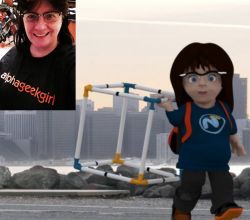In Paulo's example, he used the Chameleon preset that comes with MODO. So for the purpose of this exercise, we will too and assume you have setup your environment and lighting.
- Drag in the Chameleon mesh preset.
- In the Shader tree, delete the preset textures that came in with the mesh, but keep just the 'Chameleon on Branch' folder.
- [dcs_emptyspace h="20"]
 [dcs_emptyspace h="10"]Create a new material and set it to a vibrant colour.
[dcs_emptyspace h="10"]Create a new material and set it to a vibrant colour. - Right-click and duplicate the Chameleon Item Mesh and rename it Droplets.
- Apply a white material to the Droplets mesh and call it Condensation.
As there are now two meshes located in exactly the same space, turn off the original Chameleon. You will then see just the droplets material.
- Inside the Condensation material, go to Add Layer and insert the Pebbles texture (under Enhance:MODO Textures, Noise, Pebbles). The white areas will be where the droplets will appear on the mesh.
- [dcs_emptyspace h="20"]
 " width="“294"
" width="“294" - " height="“352"
- " />[dcs_emptyspace h="20"]To resize the droplets, go to the Texture Location tab under properties, and change Size X, Y, Z to 15 mm each.
- Under the Condensation Material change the Displacement Distance to 2 mm.
- Change the effect of the Pebble texture from Diffuse Color to Displacement.
The Pebble texture covers the entire mesh, however, you only want the droplets themselves to be visible, so you will need to make those parts that are not actual bubbles, invisible (i.e. the areas which lie flat against the skin).
- Duplicate the Pebbles texture, Invert it, and then change the Effect from Displacement to Stencil.
- With the Pebbles/Stencil effect texture selected, under the Texture Layers tab, increase the Bias to 100% to make the transition of the edges of each droplet sharper so that they touch the skin surface.
- Turn on the Chameleon mesh to view the results so far.
- To make the droplets transparent, apply a Water preset material (i.e. remove any displacement or bump layers) to the Condensation material. Drag it below the two pebbles textures.
- Change the Displacement Distance to 2 mm
To make the Chameleon metallic like Paulo did, change the material to 0% Diffuse, check Conserve Energy, Specular 20%, reflections 80%, check Blurry reflections.












 50%
50% [dcs_emptyspace h="10"]Create a new material and set it to a vibrant colour.
[dcs_emptyspace h="10"]Create a new material and set it to a vibrant colour.







